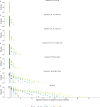Implications of the school-household network structure on SARS-CoV-2 transmission under school reopening strategies in England
- PMID: 33782396
- PMCID: PMC8007691
- DOI: 10.1038/s41467-021-22213-0
Implications of the school-household network structure on SARS-CoV-2 transmission under school reopening strategies in England
Abstract
In early 2020 many countries closed schools to mitigate the spread of SARS-CoV-2. Since then, governments have sought to relax the closures, engendering a need to understand associated risks. Using address records, we construct a network of schools in England connected through pupils who share households. We evaluate the risk of transmission between schools under different reopening scenarios. We show that whilst reopening select year-groups causes low risk of large-scale transmission, reopening secondary schools could result in outbreaks affecting up to 2.5 million households if unmitigated, highlighting the importance of careful monitoring and within-school infection control to avoid further school closures or other restrictions.
Conflict of interest statement
A.E. received a research grant from Taisho Pharmaceutical Co., Ltd. All other authors declare no competing interests.
Figures







References
Publication types
MeSH terms
Grants and funding
- NIHR200929/DH_/Department of Health/United Kingdom
- 221303/Z/20/Z/WT_/Wellcome Trust/United Kingdom
- 208812/Z/17/Z/WT_/Wellcome Trust/United Kingdom
- PR-OD-1017-20002/DH_/Department of Health/United Kingdom
- MR/P014658/1/MRC_/Medical Research Council/United Kingdom
- 16/136/46/DH_/Department of Health/United Kingdom
- 16/137/109/DH_/Department of Health/United Kingdom
- MR/N013638/1/MRC_/Medical Research Council/United Kingdom
- MC_PC_19065/MRC_/Medical Research Council/United Kingdom
- 210758/Z/18/Z/WT_/Wellcome Trust/United Kingdom
- BB/M009513/1/BB_/Biotechnology and Biological Sciences Research Council/United Kingdom
- MR/S003975/1/MRC_/Medical Research Council/United Kingdom
- 206471/Z/17/Z/WT_/Wellcome Trust/United Kingdom
- 206250/Z/17/Z/WT_/Wellcome Trust/United Kingdom
- HPRU-2012-10096/DH_/Department of Health/United Kingdom
LinkOut - more resources
Full Text Sources
Other Literature Sources
Medical
Miscellaneous

